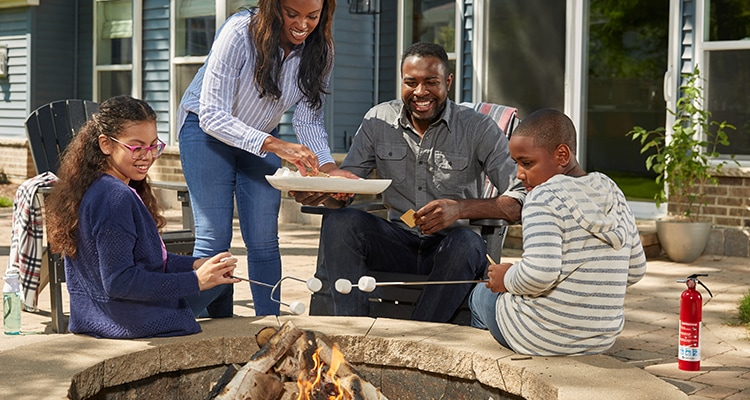Knowledge is power, they say. In the case of fire safety, that power can save a life. Let’s start with some of the basics, such as how to identify which fire extinguisher is right for which application, and how to operate different models.

There are three things to look for in a fire extinguishing device for the home: certification by a nationally-recognized testing laboratory, a metal handle, and an expiration date.
Fire extinguishers are rated for particular environments and fires. For example, an extinguisher with a 2-A: 10-B:C rating has been approved to handle typical sources of home fires, such as trash, wood, paper, liquids, and electrical equipment. Here’s a handy guide:
- A = Trash, wood, paper
- B = Liquids
- C = Electrical equipment
- D = Combustible metals
- K = Cooking oils
For general home protection, select a multi-rated model—such as the First Alert HOME1 Rechargeable Home Fire Extinguisher. It’s made with a durable metal head and features a metal pull pin, with a safety seal that deters accidental discharge and discourages tampering, and it comes with a mounting bracket and strap. A colour-coded gauge is easy-to-read, corrosion-resistant, and provides accurate measurement; instructions for use are right on the can.
TIP: Be aware that rechargeable extinguishers should be checked annually by a certified professional, and refilled after being discharged.
For small, contained fires—in, say, a pan, or wastebasket—there’s a new lightweight EZ Fire Spray can model from First Alert. There are no pins to pull or levers to squeeze – just point, spray and the fire is out! The unit is simple to use, and at just $20, it makes sense to add one to other spaces, such as laundry- and work-rooms, basements and garages.
Remember that fire extinguishers don’t last forever—generally, they’ll have a six-year life expectancy.

Nervous about using a fire extinguisher? Don’t be. Research from the Fire Equipment Manufacturers’ Association has found that even people with no training can safely and effectively use a fire extinguisher during an emergency. It’s something that all adults should know how to do, and it’s easy if you follow the PASS model:
- Pull the pin. Hold the extinguisher with the nozzle pointing away from you and release the locking mechanism.
- Aim low. Point the extinguisher at the base of the fire.
- Squeeze the lever slowly and evenly.
- Sweep the nozzle from side-to-side.
And while you’re thinking about fire safety, why not take time to check smoke and CO alarms? This is a great time of year to do; according to the National Fire Protection Association, the risk of dying in a reported home fire is cut in half in homes with working smoke alarms, and home fires occur more in the winter than any other season.
For more useful information on fire safety, please visit National Fire Prevention Week.
This is a sponsored post. First Alert did not review content prior to publication. I think the company make excellent products and I believe in the need to raise awareness of fire safety in the home.



